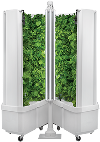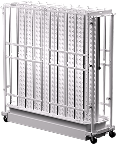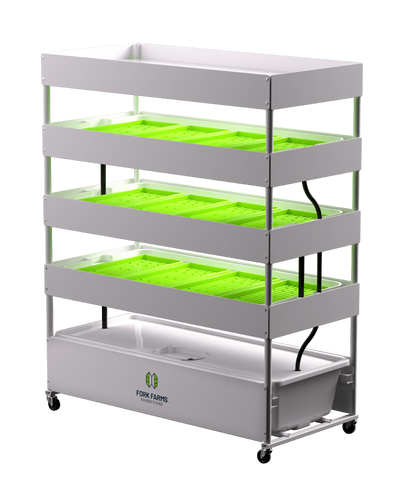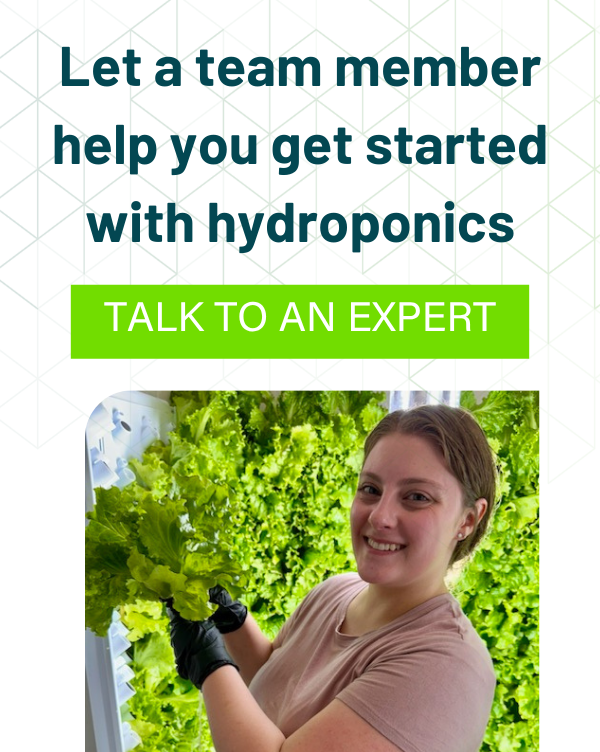11 Advantages of Hydroponic Fruits and Vegetables
Picture it - outer space, the final frontier. Many incredible achievements of mankind have been accomplished in space, and it turns out, that includes gardening. In 2014, NASA's Vegetable Production System, known as "Veggie," deployed on the International Space Station (ISS). This made it possible for astronauts to have fresh produce and study plant growth. Interest in and studies of hydroponics in space have continued to increase, with one of the most recent experiments from 2021 when chile peppers were grown hydroponically aboard the ISS.
The ability to grow crops in a controlled environment in space is indicative of the potential of the growth of this technology across the globe. The produce grown on the ISS is grown in a very unique and almost impossible growing environment. With hydroponics, everyone can have access to fresh foods and nutrition regardless of their location.
Why do Gardeners Love Hydroponic Fruits and Vegetables?
With agricultural technology advancing everyday, restaurants, communities, businesses and schools are discovering success with hydroponics. Advantages of growing fresh fruits and vegetables hydroponically include:
1) Hydroponic systems take up a small amount of space.
Whether someone is looking to grow produce for a whole school district or for a small family, hydroponics is a scalable growth solution that can be tailored around specific goals. Vertical systems are perfect for small and compact indoor spaces such as classrooms, allowing indoor farmers to grow foods like leafy greens, tomatoes and mini peppers efficiently and sustainably.
2) Hydroponic systems produce a high yield of fresh foods.
Many vegetables and herbs like lettuces and basil produce very high yields when grown hydroponically. Vertical growing systems, many with more than 250 plant spaces, make it feasible to grow and harvest more than 25 pounds of leafy greens in four weeks.
3) Hydroponics often result in higher profits.
Once the indoor hydroponic farm is up and running, there are many cost-saving benefits to growing hydroponically vs. traditional agriculture since issues with climate change, natural disasters, and pest infestation are eliminated. The hydroponic growing environment is streamlined, consistent, planned, and known. There are no tractors to maintain and there is no soil to tend to. And, with hydroponic farms, you can move quickly to grow new foods to meet consumer demand or to meet your individual needs. This is especially true with green leafy greens that are very easy and fast to grow in the hydroponic environment. As mentioned earlier, yields and outcomes of fresh foods are highly predictable in a hydroponic environment which translates to high-quality foods, less waste, and ultimately profitability.
4) Hydroponics often provide higher quality produce and herbs.
In hydroponic growing, the nutrient mix can be tailored to meet the specific needs of the plant, therefore producing crops that can be more nutrient-dense. Since hydroponic fruits and vegetables are grown in protective environments, they suffer less from natural stress factors. This means that they can sometimes contain even more vitamins than soil-grown vegetables at the time of harvest. Since hydroponic foods are grown on-site they don’t lose any nutrients in transit, and are among the freshest and most healthy foods to consume.
5) Hydroponics supports the growth of healthy herbs.
Herbs are easy to grow in hydroponic systems and have a range of health benefits. Peppermint and ginger can reduce nausea, turmeric may help with arthritis, and green tea can help with weight loss.
6) Hydroponics grow plants that thrive in wet conditions.
Hydroponic growing is efficient, sustainable and uses less resources than traditional agriculture. Compared to traditional agriculture, our Flex Farm requires zero food miles to be traveled, provides 45 times more food production, and uses 98 percent less water and land. Hydroponic growing is good for the environment and good for bodies.
7) Hydroponics grow plants vertically.
Many hydroponic systems are vertical, making them a great choice to grow fresh produce in small spaces. Everything from peppers to beans to small melons (ideally grown vertically), to strawberries and swiss chard (not traditionally grown vertically) can be grown alongside each other, offering variety and efficiency.
8) Hydroponics grow plants that benefit from exact temperatures.
There are so many types of produce that need certain temperatures and climates to grow effectively. Vegetables such as yard-long beans, okra, and eggplants thrive in hot temperatures, while carrots, cauliflower, and broccoli prefer cold temperatures. Since hydroponic systems are fully controlled environments, many crops can be successfully grown with ease, which reduces maintenance time and growing costs.
9) Hydroponics Makes Growing Exotic Vegetables and Fruits Possible.
Since hydroponic systems can be adjusted and tailored to various crops, farmers have the opportunity togrow more exotic vegetables and fruits. Tropical fruits such as pineapples, lemons, and limes can be grown in places like Alaska if hydroponic systems are used! Many companies offer assistance, customer support and ongoing tutorials to help answer all of your questions and get you growing.
10) Indoor Gardens allow for year-round growing and harvesting.
Speaking of Alaska, with hydroponics, no produce is out of season - ever. We think the primary benefit of an indoor hydroponic garden is the ability to grow produce year-round from nearly anywhere in the world. This is vital to communities prone to drought, floods, shortened growing seasons, and severe weather. Year-round growing is also crucial to communities without regular access to fresh produce, known as food deserts. Hydroponics can also help combat food insecurity, climate change, and weather instability around the world. Places like the Caribbean islands that suffer from these issues greatly benefit from hydroponics and use our Flex Farms in schools, regeneration projects, skill-building programs, and more to guarantee access to fresh foods at all times.
11) Introduction of new flavors and foods across the globe.
The ability to grow and harvest year-round can also introduce new flavors and foods to different regions. With hydroponics, drier climates can access produce that is typically grown in wetter environments, such as watercress, while colder climates can have access to vegetables like broccoli, which is typically grown more easily in warmer temperatures. With the opportunity to grow a wide variety of fruits and vegetables anywhere and anytime, options and offerings are vast with hydroponic growing.
Fork Farms Here to Help
Hydroponic growing solutions can help farmers create a thriving farm that provides fresh, healthy, highly-nutritious produce year-round. Whether it’s a small hydroponic garden at home or a large commercial growing system, Fork Farms can help growers and farmers tap into the advantages of producing hydroponic fruits and vegetables.
To learn more about hydroponic growing options and how Fork Farms can support your hydroponic growing goals, reach out to one of our expert team members today using the form below!























